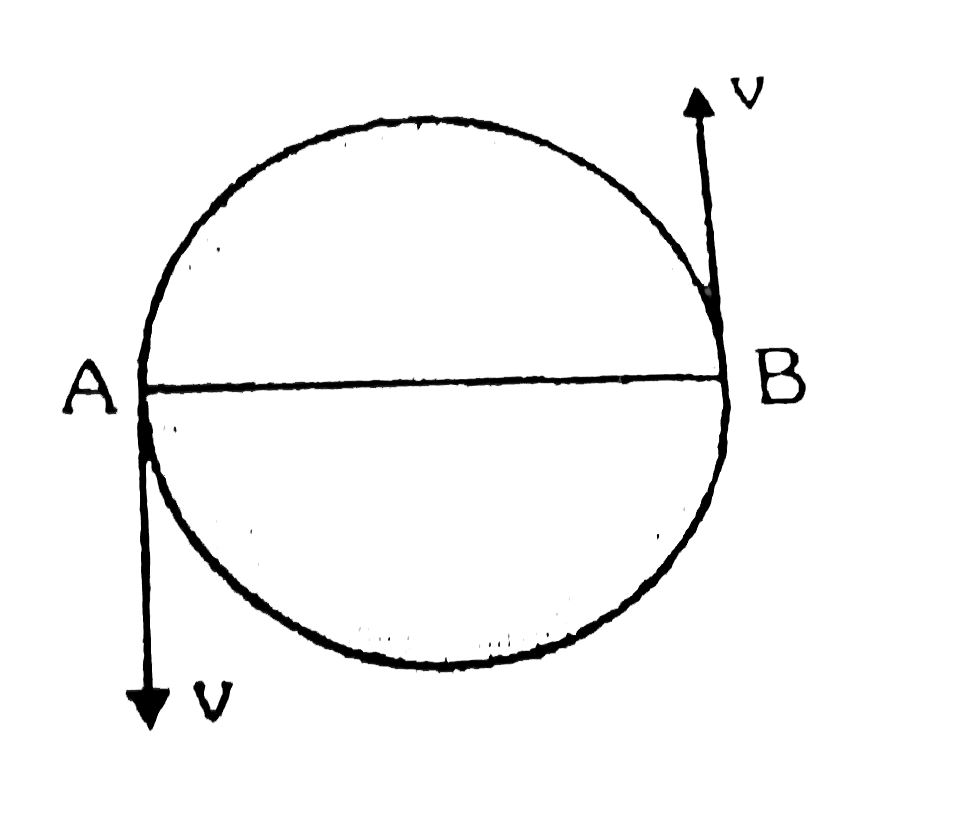Two particles A and B move anticlockwise with the same speed v in a circle of radius R and are diametrically opposite to each other. At t=0, A is given a constant accelerartion (tangential) at=72v225πR. Calculate the time in which a collides with B, the angle traced by A, its angular velocity and radial acceleration at the time of collision.
The correct Answer is:5πR6v,11π6,17v5R,289v225R
According to
θ=12×72v225πR×t2=πR⇒t=5πR6v
Using Rθ=vt+(12)72v225πR×25π2R236v2
aT=72v225πR
Rθ=v5πR6v+πR=116π
Angular velocity :ω=ωv+αt
=vR+72v225πR2×5πR6v=vR+12v5R=17v5R
Angular acceletration α=ω2R=289v225R

Topper's Solved these Questions
- KINEMATICSBOOK - ALLENCHAPTER - KINEMATICSEXERCISE - Exercise-04[B]
14 Videos
- KINEMATICSBOOK - ALLENCHAPTER - KINEMATICSEXERCISE - Exercise-05 [A]
11 Videos
- KINEMATICSBOOK - ALLENCHAPTER - KINEMATICSEXERCISE - Comprehension#7
3 Videos
- ERROR AND MEASUREMENTBOOK - ALLENCHAPTER - ERROR AND MEASUREMENTEXERCISE - Part-2(Exercise-2)(B)
22 Videos
- KINEMATICS (MOTION ALONG A STRAIGHT LINE AND MOTION IN A PLANE)BOOK - ALLENCHAPTER - KINEMATICS (MOTION ALONG A STRAIGHT LINE AND MOTION IN A PLANE)EXERCISE - BEGINNER S BOX-7
8 Videos
Similar Questions
The speed (v) of a particle moving in a circle of radius R varies with distance s as v=ks where k is a positive constant.Calculate the total acceleration of the particle
View SolutionTwo particles AandB move on a circle Initially, particles AandB are diagonally opposite to each other. Particle A moves with angular velocity πrads−1 and angular acceleration π/2rads−2 and particle B moves with constant angular velocity 2πrads−2. Find the time after which both the particlsd AnadB will collide.
View Solution
Knowledge Check
A particle with the constant speed in a circle of radius r and time period T.The centripetal acceleration of a particle is
A‘r2‘TB‘T2‘rC(2πT)2rD(2πT)2rIf the body is moving in a circle of radius r with a constant speed v , its angular velocity is
Av2/rBvrCv/rDr/vTwo particles A and B separated by a distance 2R are moving counter clockwise along the same circular path of radius R each with uniform speed v. At time t=0, A is given a tangential acceleration of magnitude a=32v225πR in the same direction of initial velocity
AThe time lapse for the two bodies to collide is 6πR5VBThe angle coverd by A is 9π4CAngular velocity of A is 11V5RDRadial acceleration of A is 289υ25R
A particle moves with constant speed v along a circular path of radius r and completes the circle in time T. The acceleration of the particle is
View SolutionA particle of mass M is moving in a horizontal circle of radius R with uniform speed V. When it moves from one point to a diametrically opposite point, its
View SolutionA particle of mass M is moving in a horizontal circle of radius R with uniform speed V. When it moves from one point to a diametrically opposite point , its
View SolutionTwo bodies are moving with constant speed v clockwise and are initially diagonally opposite. The particle B now acheives a tangential acceleration of a m/s2. Then :

View SolutionA particle moves in circle of radius R with a constant speed v. Then, find the magnitude of average
acceleration during a time interval πR2v.
View Solution
